Papers by Appoline H-Romanens

Graded 14/20 at the ENSSIB by Dr. Eric Guichard Nowadays, scholars are faced with APCs, they need... more Graded 14/20 at the ENSSIB by Dr. Eric Guichard Nowadays, scholars are faced with APCs, they need to use a CAM software with some DMP in order to be integrated into the DOAJ’s database, or hope to be featured on WoS. These terms seem different from the lingo of the 1776 "Philosophical Transactions of the Royal Society" journal, [Atkinson, 1996], the first manifestation of the compiled thoughts of scientific research in London. These terms signal, however, the evolution of the medium which transcribes the academic paper, which is online-published data today, onto which any scientific paper must appear so as to be immune to the "publish or perish" disease. In order to understand the new lingo of scientific research, which is proof of a major shift regarding the link that an academic, the editor, publisher and the reader feel vis-a-vis the text, this Master’s Thesis tackles the notion of disruption in the process of creation, reviewing, editing, publishing and the sharing process of an article. Besides developing the theories of what a document and a scientific paper are, this Master’s Thesis proposes two case studies reporting on the disruption phenomenon in scientific publishing, and introduces perspectives, from this corpus, on the current and upcoming issues regarding scientific publishing.
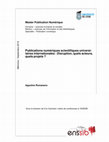
Master's Thesis Digital Publishing, 2019
Graded 14/20 at the ENSSIB by Dr. Eric Guichard
Nowadays, scholars are faced with APCs, they nee... more Graded 14/20 at the ENSSIB by Dr. Eric Guichard
Nowadays, scholars are faced with APCs, they need to use a CAM
software with some DMP in order to be integrated into the DOAJ’s
database, or hope to be featured on WoS. These terms seem different
from the lingo of the 1776 "Philosophical Transactions of the Royal
Society" journal, [Atkinson, 1996], the first manifestation of the compiled thoughts of scientific research in London. These terms signal,
however, the evolution of the medium which transcribes the academic
paper, which is online-published data today, onto which any scientific paper must appear so as to be immune to the "publish or perish"
disease. In order to understand the new lingo of scientific research,
which is proof of a major shift regarding the link that an academic, the
editor, publisher and the reader feel vis-a-vis the text, this Master’s
Thesis tackles the notion of disruption in the process of creation,
reviewing, editing, publishing and the sharing process of an article.
Besides developing the theories of what a document and a scientific
paper are, this Master’s Thesis proposes two case studies reporting on
the disruption phenomenon in scientific publishing, and introduces
perspectives, from this corpus, on the current and upcoming issues
regarding scientific publishing.
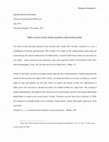
Graded 17/20 at the ENS of Lyon
The concept of gender performativity, developed by the American ... more Graded 17/20 at the ENS of Lyon
The concept of gender performativity, developed by the American activist and feminist and post-structuralist philosopher Judith Butler is central in her essay Gender Trouble, Feminism and the Subversion of Identity. In 1990, she introduced a groundbreaking vision to feminist critique theory, mainly, that gender expression can be (in)visible:
“Gender is, (...) a construction that regularly conceals its genesis’’ (Butler, 190).
1 They, their: Gender inclusive pronouns will be used in this paper as an alternative to “he’’ or “she’’ to respect one’s gender pronoun of choice.
Hontaas-Romanens 1
The question raised by this statement, that of genesis, will not create a paper arguing on what’s the form of gender genesis in a biological setting, but rather on how and why society and the individual reform the (in)visible of gender. Is gender a visible body in society? Studying the last part of Butler’s Gender Trouble, “Bodily inscription, performative subversions”, (3, iv), I will explain her idea claiming that the body is an invisible and stigmatized space in history first of all, pointing out second of all to the fact that the visibility of a gendered body is blurry and blurred through her example of drag performances.
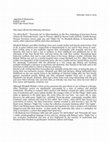
Elizabeth Bishop’s and Allen Ginsberg’s lives were mostly similar and shared controversies. First... more Elizabeth Bishop’s and Allen Ginsberg’s lives were mostly similar and shared controversies. First of all, as queer authors born respectively in Massachusetts in 1911 and in New Jersey in 1926 , their writing more or less explicitly exposes their relationship with sexuality and loss, two domains they had to find a way to embrace in their childhood and adulthood, her in the aftermath of the First World War, and him before the Cold War conflict. Throughout these historical conflicts, they had to cope with those of the home. Bishop’s mother, Gertrude May Bulmer Bishop was sent to a mental hospital when young Elizabeth was five. Allen Ginsberg’s mother was supportive of the Communist party, she was a nudist and her mental illness worried her entourage. Confronted with the abnormal at a very young age, Bishop and Ginsberg probably developed a tolerance to psychosis and dementia, they learned in the body and in the mind how to find relief in a literal or literary uneasiness.
Second of all, writing therefore transcribes how mentally strong they were, in facing the pain, in facing their non-normative moeurs. Elizabeth and Allen had partners, Bishop befriended Alice Methfessel as she was mainly living in the buildings of Harvard College after her first female partner committed suicide. Bishop and Alice remained together from 1971 to 1979, until Elizabeth’s last breath. Similarly, Allen had a thirty three years long relationship with the poet and actor Peter Orlovsky who survived Allen as Orlovsky was sixty four when his lover died of liver cancer and hepatitis. (Axelrod, 173)
Valerie Solanas 1967 SCUM Manifesto, an acronym standing for Society for Cutting Up Men presents ... more Valerie Solanas 1967 SCUM Manifesto, an acronym standing for Society for Cutting Up Men presents the radical feminist’s polity and ideas on first of all all the flaws noticed in the current behavior of society for it is functioning upon the command of men, being an ‘’utter bore’’,
Graded 5/5 at UC Riverside
The Invisible War is an American documentary directed by Kirby Dic... more Graded 5/5 at UC Riverside
The Invisible War is an American documentary directed by Kirby Dick, (2012) exposing the visible truth made invisible about the reality of rape happening in any corps of the American Army. “I remember holding the closet and thinking: “What just happened?’’, Female US Coast Guard Kori Cioca reveals to the camera, in tears. Over 20% of female veterans have been sexually assaulted while serving (US Government Studies Statistics). In addition to denying their traumatic experiences, men and women soldiers face the Department of Defense’s reluctance to help them and prosecute the perpetrators. Victims are given lethal medication and ‘’told to suck it up’’, the documentary reports.
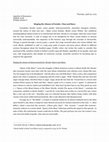
A grade UC Riverside
Gwendolyn Brooks’ poetry voices gender; heteronormativity, masculine miso... more A grade UC Riverside
Gwendolyn Brooks’ poetry voices gender; heteronormativity, masculine misogyny–violence, around the notion of class and race ; Males versus females. Blacks versus Whites. Her multiform autobiographical release invites us to read between the lines. Brooks is a surrogate, when she voices issues that her time unvoiced. A code of images has to be deciphered for these voiced matters to become universally understandable. Her depiction of life between 1945 through the seventies in Bronzeville, Chicago is passed through a sonore poetry, a poetry that sings mournful pleas and riotous ballads. Her work, Blacks, published in 1987 is a long song made of poems and prose pieces offered in different sections throughout about five hundred pages. Prolific writer, she invites the reader to consider this portrayal of life, somehow similar to Robert Lowell’s 1959 Life Studies, regardless of our gender, class and race, with songs-poems, that despite its numerous wounds, reconciles ourselves by becoming epic to empower the oppressed.
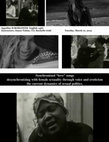
Graded 94/100 at UC Riverside
I made this Nevsky digram inspired double Graphical Score to be ab... more Graded 94/100 at UC Riverside
I made this Nevsky digram inspired double Graphical Score to be able to conveniently present to my readers a way to parallel and contrast two of our visual materials screened in class. I was first of all interested , in my first project, in studying Beyonce’s “Drunk in Love’’ music video; the freedom that perspired from the video, the aesthetic beauty and catchiness of the music, as well as the mystery of black and white choices of film editing made me choose this one in January. Somehow, it remotely reminded me of a Herb Ritts' video for Madonna’s song, “Cherish’’ that seemed to, if my memory served me right at that time, share the same aesthetic qualities with Beyoncé’s video and respond to it.
I realized in a few months that Beyoncé’s open display of sexuality was not done in a ‘’loose’’ way or in a way to attract viewers, but rather to embody a feminist vision of African American artists and claims versus those of male rappers/singers..Just like the music and the video shared this essayist quality of freedom and beauty, Beyoncé Knowles tries to carry them in her life but also as an artist in her albums. She wants women to rise and take back the power History ravished from them and affirm their eroticism, their proud, free and pure sexuality.The Texan star constantly conveys this message in her videos.She also, in this quest to voice the empowerment, speaks for other communities, not just Black Americans, but for instance the LGBTIQ community. By so doing, she desynchronizes the current dynamics of sexual politics through the erotic and other means that demonstrate her and others’ agencies.
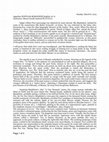
Graded A at UC Riverside March 2015
Edgar (Allan) Poe’s personage was admired by some abroad- ... more Graded A at UC Riverside March 2015
Edgar (Allan) Poe’s personage was admired by some abroad- like Baudelaire, loathed by some of his countrymen like Rufus Griswold –at home. He was criticized by the latter who, betraying Poe, wrote the 1850 biography Memoir of the Author. (Poe, 2426). When Poe died on October, 7, 1849, Griswold published his article “Death of Edgar Allan Poe- Quoth the Raven Never more! (...) This announcement will startle many, but few will be grieved by it.’’ The analysis of Poe’s poétique or art of poetry speaks as an escape for a tortured and ‘’doomed poet’’ marked by Charles Baudelaire’s themes of the poète maudit. Misunderstood for a lifetime, Poe desperately sought an ‘’Eldorado’’ personified in goddess-like women. However, as this poem concludes, there is neither salvation in women nor in life. His macabre light was the birthplace of the gothic short story, horror, and an early form of science fiction.
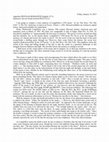
Graded A- at UC Riverside
I am going to conduct a close analysis of Longfellow’s 1879 poem ‘’As ... more Graded A- at UC Riverside
I am going to conduct a close analysis of Longfellow’s 1879 poem ‘’As the Tide Rises, The Tide Falls’’ in The New Anthology of American Poetry, Volume 1, 258). Stressed syllables are written in capital letters, unstressed syllables are underlined.
Henry Wadsworth Longfellow was a famous 19th century Harvard scholar, American poet and translator, born in Maine in 1807. His fame was comparable to that of Edgar Allan Poe. In 1841, he described Longfellow as “unquestionably the best poet in America.” His poetry revolves around traveling and the elements, fire, or the marine theme. Longfellow’s 1850 poem The Secret of the Sea brings the memory of a dream and invites the reader to travel: ‘For the secret of the sea,/And the heart of the great ocean/Sends a thrilling pulse through me.’’However, three years before his demise, the ocean now signifies death personified. In his 1879 poem ‘’As the Tide Rises, The Tide Falls’’ this anaphora carries the sound of the rising and falling rhythm of the tide to take the reader to a gloomier landscape in this struggle between darkness and light. The traveller knows the journey is coming to an end.
I shall focus on the visual aspect of the poem and its imagery (I), to then pay attention to the meter, rhythm and its musicality (II), these elements being crucial to reveal the meaning of it and the poetical issue it addresses. (III).
Graded 95/100 at UC Riverside
Explore and analyze the relationship music entertains with affec... more Graded 95/100 at UC Riverside
Explore and analyze the relationship music entertains with affects and effects, metaphors and meanings
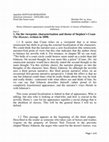
Graded 93/100 at UC Riverside
19th century lit final exam
Henry Johnson’s appearance around the ... more Graded 93/100 at UC Riverside
19th century lit final exam
Henry Johnson’s appearance around the issue of slavery: A victory of blackness v. whiteness.
Part I:
1. On the viewpoint, characterization and theme of Stephen’s Crane The Monster, written in 1898:
1.1 It seems that Crane relies on a viewpoint that is at times omniscient but shifts to giving the external focalization of the characters. We could think that the narrator uses a zero focalization (the omniscient, narrator-God point of view) but this clue indicates that the author chose to balance his novella with it. For instance, in chapter III we can read: ‘’“No belle of a court circle could bestow more mind on a toilet than did Johnson. On second thought, he was more like a priest’’ (Crane, 26). An omniscient narrator would have directly stated the second thought as the main thought. Via this stylistic choice, the narrator plunges us into the thoughts of the character, here, Henry Johnson. So although the novella uses a third person narrative, this third person narrative relies on an occasional first-person narrative perspective. I think the effect is that no one but Johnson could share what he really thinks about the way he look and really thinks, contrasted with what others see and think of him. So we can say that Johnson describes himself, rather proud of his completely transformed appearance, and the narrator’s voice blends in with Johnson’s.
This issue around focalization is linked to that of appearance. Who is talking, but also who is looking at what/who, and how is crucial in the novella. Henry’s care for his appearance signifies a social change that is the abolition of slavery. This will be the general thesis I will try to defend.

Graded 92/100 at UC Riverside
This paper of 4,030 words will present a multifaceted level of r... more Graded 92/100 at UC Riverside
This paper of 4,030 words will present a multifaceted level of reading of the film released in the United States in 2009 and directed by Javier Fuentes - Léón, Undertow , to explore the complex relationship love cultivates with beauty, shame and sorrow in the film but also with words and images. Undertow, confer a succession of images, sounds and emotions challenges you to actively think about what you feel through what the director wants you to see. Speaking of sounds, I have included three tracks you are invited to listen to during the visual and verbal account of what are I believe three key moments in the film. The first one will surround the scene when Miguel and Santiago passionately make love, the second one will embrace Miguel’s morning when he wakes up alone on the beach, and the third will be an elegy to Santiago as he departs forever. By creating those pieces, I wanted to skim the soul of the film and make it live, for the issues it deals with are part of our society’s concerns.You will be given the power to decide what scene appeals the most to you, according to your own definition of beauty showcased in words, images and sounds.
Graded 95/100 at University of California, Riverside
In Benito Cereno, Babo resembles Herman Mel... more Graded 95/100 at University of California, Riverside
In Benito Cereno, Babo resembles Herman Melville’s Bartleby. Babo seldom speaks; when he does, his speech is enigmatic. He could be the central character of the 1855 novella, for Babo wittily listens, obeys everyone until the climax in the story : The mutiny onboard the ship Saint Dominick. Serving his master Don Benito Cereno, Babo acts as a slave until this particular event. The story thus undermines the Hegelian dialectic of master and slave, but what about the fact that Babo seems to already be the master, long before the mutiny his words foreshadowed?
---- Graded 100/100 at UC Riverside
Graded 90/100 at UC Riverside
In another novel, Giovanni’s Room published in 1956, Baldwin explo... more Graded 90/100 at UC Riverside
In another novel, Giovanni’s Room published in 1956, Baldwin explores the relationship between gay love, public opinion and shame in a physical as well as ideological jail. The Room not only is an apartment but also the embodiment of one’s body, trapped in its self.
In this quest between love, life and death, isn’t the ultimate point of no return a way to deny who we are and how we feel, although it seems to be a relatively painless way to run away from the enigma, that is what we are, which is what threatens us?
---- graded 90/100 at the University of California, Riverside
Graded B+ at UC Riverside
To exist, a nation needs to weave its own kind of myths and legends.... more Graded B+ at UC Riverside
To exist, a nation needs to weave its own kind of myths and legends. Those legends create deeply-rooted values through exceptionalism ; the idea of a perfect nation is born. And this is how Amer- ican literature began to speculate to imagine America, as did the New Yorker Washington Irving’s who wrote “Rip Van Winkle’’ in 1819. Rip Van Winkle could be read as a Janus-like figure because he seems to represent both the oppressed Native Americans on one hand and perhaps also the boasting and power- ful colonialist
Is Rip Van Winkle this non-normative male character who has to undergo the changes of his society, or could we read him as the violent and boasting colonialist who oppressed Native people?
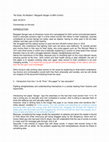
Margaret Sanger was an American nurse who campaigned for birth control and planned parenthood to ... more Margaret Sanger was an American nurse who campaigned for birth control and planned parenthood to advocate women's right in a time where women felt inferior to their husbands, scarcely considered as human beings but solely used as objects, having no other goal in life but bear children and take care of their hearths.
Her struggles led this radical woman to open the first US birth control clinic in 1916.
However, she understood that fighting tooth and nail alone was inefficient. To include women and involve them in this race for their rights, she wrote papers such as The Woman Rebel in 1914 and other books in which she is basically explaining to women to what extent their sexual liberation has to do with a struggle between classes, benightedness and fear.
Hence the importance of the latter, because prior to shedding light on the most relevant issues torturing women at the time - birth control and their health during or after childbirth- the aim of this paper is to awaken working class and upper class women to their conditions in an ever changing society. "It is hoped the young girl will derive some knowledge of her nature, and conduct her life upon such knowledge."
In 1914, women in the United-States did not have the right to vote in most states, they were not ... more In 1914, women in the United-States did not have the right to vote in most states, they were not educated the same way; Anti-obscenity laws or Comstock laws were double-standard type of laws allowing unfaithful husbands to obtain condoms to protect themselves from venereal diseases but prohibited its contraceptive use by couples. Margaret Sanger had experienced the horrors and dangers of home abortion when she was a nurse in the immigrant neighborhood of New-York’s Lower-east-Side, also, her experience as a labour organiser during the Lawrence Strike of 1912 taught her how to protest and reach a wide audience and slogan on her magazine “No gods no masters” which was used during the demonstrations.
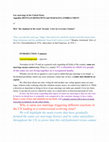
Nowadays in the US and on a general scale regarding all fields of the country, same-sex
marriage ... more Nowadays in the US and on a general scale regarding all fields of the country, same-sex
marriage means controversy. What is it, simply? It's a situation in which two people of the same sex are living together as a recognized family.
Whether you are for or against it, you’ve got to admit that gay marriage is no longer a far-fetched possibility which can cross someone’s mind, but, in fact, a reality that should be ac- cepted.
We often hear about one state voting for and another one voting against same-sex mar- riage, without really realizing what this situation means, hence, its controversy linked to it. While a decision as important as being in favor of gay marriage can make gay people’s lives ten times easier, it can also be seen as a threat by some, in a conservative or heterosexual point of view.
In fact, the first issue regarding this aspect of same-sex marriage is that no one real- ly knows in detail how it originally was compared to the constant changes it faces today. Hence a sense of fear and repulsion on one hand, and a deeply-rooted will to have it legal- ized and recognized, on the other hand.
Why is same-sex marriage triggering different reactions in the US leading to a controversial evolving issue?






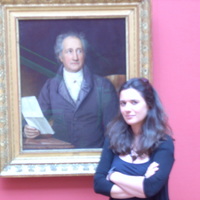




Uploads
Papers by Appoline H-Romanens
Nowadays, scholars are faced with APCs, they need to use a CAM
software with some DMP in order to be integrated into the DOAJ’s
database, or hope to be featured on WoS. These terms seem different
from the lingo of the 1776 "Philosophical Transactions of the Royal
Society" journal, [Atkinson, 1996], the first manifestation of the compiled thoughts of scientific research in London. These terms signal,
however, the evolution of the medium which transcribes the academic
paper, which is online-published data today, onto which any scientific paper must appear so as to be immune to the "publish or perish"
disease. In order to understand the new lingo of scientific research,
which is proof of a major shift regarding the link that an academic, the
editor, publisher and the reader feel vis-a-vis the text, this Master’s
Thesis tackles the notion of disruption in the process of creation,
reviewing, editing, publishing and the sharing process of an article.
Besides developing the theories of what a document and a scientific
paper are, this Master’s Thesis proposes two case studies reporting on
the disruption phenomenon in scientific publishing, and introduces
perspectives, from this corpus, on the current and upcoming issues
regarding scientific publishing.
The concept of gender performativity, developed by the American activist and feminist and post-structuralist philosopher Judith Butler is central in her essay Gender Trouble, Feminism and the Subversion of Identity. In 1990, she introduced a groundbreaking vision to feminist critique theory, mainly, that gender expression can be (in)visible:
“Gender is, (...) a construction that regularly conceals its genesis’’ (Butler, 190).
1 They, their: Gender inclusive pronouns will be used in this paper as an alternative to “he’’ or “she’’ to respect one’s gender pronoun of choice.
Hontaas-Romanens 1
The question raised by this statement, that of genesis, will not create a paper arguing on what’s the form of gender genesis in a biological setting, but rather on how and why society and the individual reform the (in)visible of gender. Is gender a visible body in society? Studying the last part of Butler’s Gender Trouble, “Bodily inscription, performative subversions”, (3, iv), I will explain her idea claiming that the body is an invisible and stigmatized space in history first of all, pointing out second of all to the fact that the visibility of a gendered body is blurry and blurred through her example of drag performances.
Second of all, writing therefore transcribes how mentally strong they were, in facing the pain, in facing their non-normative moeurs. Elizabeth and Allen had partners, Bishop befriended Alice Methfessel as she was mainly living in the buildings of Harvard College after her first female partner committed suicide. Bishop and Alice remained together from 1971 to 1979, until Elizabeth’s last breath. Similarly, Allen had a thirty three years long relationship with the poet and actor Peter Orlovsky who survived Allen as Orlovsky was sixty four when his lover died of liver cancer and hepatitis. (Axelrod, 173)
The Invisible War is an American documentary directed by Kirby Dick, (2012) exposing the visible truth made invisible about the reality of rape happening in any corps of the American Army. “I remember holding the closet and thinking: “What just happened?’’, Female US Coast Guard Kori Cioca reveals to the camera, in tears. Over 20% of female veterans have been sexually assaulted while serving (US Government Studies Statistics). In addition to denying their traumatic experiences, men and women soldiers face the Department of Defense’s reluctance to help them and prosecute the perpetrators. Victims are given lethal medication and ‘’told to suck it up’’, the documentary reports.
Gwendolyn Brooks’ poetry voices gender; heteronormativity, masculine misogyny–violence, around the notion of class and race ; Males versus females. Blacks versus Whites. Her multiform autobiographical release invites us to read between the lines. Brooks is a surrogate, when she voices issues that her time unvoiced. A code of images has to be deciphered for these voiced matters to become universally understandable. Her depiction of life between 1945 through the seventies in Bronzeville, Chicago is passed through a sonore poetry, a poetry that sings mournful pleas and riotous ballads. Her work, Blacks, published in 1987 is a long song made of poems and prose pieces offered in different sections throughout about five hundred pages. Prolific writer, she invites the reader to consider this portrayal of life, somehow similar to Robert Lowell’s 1959 Life Studies, regardless of our gender, class and race, with songs-poems, that despite its numerous wounds, reconciles ourselves by becoming epic to empower the oppressed.
I made this Nevsky digram inspired double Graphical Score to be able to conveniently present to my readers a way to parallel and contrast two of our visual materials screened in class. I was first of all interested , in my first project, in studying Beyonce’s “Drunk in Love’’ music video; the freedom that perspired from the video, the aesthetic beauty and catchiness of the music, as well as the mystery of black and white choices of film editing made me choose this one in January. Somehow, it remotely reminded me of a Herb Ritts' video for Madonna’s song, “Cherish’’ that seemed to, if my memory served me right at that time, share the same aesthetic qualities with Beyoncé’s video and respond to it.
I realized in a few months that Beyoncé’s open display of sexuality was not done in a ‘’loose’’ way or in a way to attract viewers, but rather to embody a feminist vision of African American artists and claims versus those of male rappers/singers..Just like the music and the video shared this essayist quality of freedom and beauty, Beyoncé Knowles tries to carry them in her life but also as an artist in her albums. She wants women to rise and take back the power History ravished from them and affirm their eroticism, their proud, free and pure sexuality.The Texan star constantly conveys this message in her videos.She also, in this quest to voice the empowerment, speaks for other communities, not just Black Americans, but for instance the LGBTIQ community. By so doing, she desynchronizes the current dynamics of sexual politics through the erotic and other means that demonstrate her and others’ agencies.
Edgar (Allan) Poe’s personage was admired by some abroad- like Baudelaire, loathed by some of his countrymen like Rufus Griswold –at home. He was criticized by the latter who, betraying Poe, wrote the 1850 biography Memoir of the Author. (Poe, 2426). When Poe died on October, 7, 1849, Griswold published his article “Death of Edgar Allan Poe- Quoth the Raven Never more! (...) This announcement will startle many, but few will be grieved by it.’’ The analysis of Poe’s poétique or art of poetry speaks as an escape for a tortured and ‘’doomed poet’’ marked by Charles Baudelaire’s themes of the poète maudit. Misunderstood for a lifetime, Poe desperately sought an ‘’Eldorado’’ personified in goddess-like women. However, as this poem concludes, there is neither salvation in women nor in life. His macabre light was the birthplace of the gothic short story, horror, and an early form of science fiction.
I am going to conduct a close analysis of Longfellow’s 1879 poem ‘’As the Tide Rises, The Tide Falls’’ in The New Anthology of American Poetry, Volume 1, 258). Stressed syllables are written in capital letters, unstressed syllables are underlined.
Henry Wadsworth Longfellow was a famous 19th century Harvard scholar, American poet and translator, born in Maine in 1807. His fame was comparable to that of Edgar Allan Poe. In 1841, he described Longfellow as “unquestionably the best poet in America.” His poetry revolves around traveling and the elements, fire, or the marine theme. Longfellow’s 1850 poem The Secret of the Sea brings the memory of a dream and invites the reader to travel: ‘For the secret of the sea,/And the heart of the great ocean/Sends a thrilling pulse through me.’’However, three years before his demise, the ocean now signifies death personified. In his 1879 poem ‘’As the Tide Rises, The Tide Falls’’ this anaphora carries the sound of the rising and falling rhythm of the tide to take the reader to a gloomier landscape in this struggle between darkness and light. The traveller knows the journey is coming to an end.
I shall focus on the visual aspect of the poem and its imagery (I), to then pay attention to the meter, rhythm and its musicality (II), these elements being crucial to reveal the meaning of it and the poetical issue it addresses. (III).
Explore and analyze the relationship music entertains with affects and effects, metaphors and meanings
19th century lit final exam
Henry Johnson’s appearance around the issue of slavery: A victory of blackness v. whiteness.
Part I:
1. On the viewpoint, characterization and theme of Stephen’s Crane The Monster, written in 1898:
1.1 It seems that Crane relies on a viewpoint that is at times omniscient but shifts to giving the external focalization of the characters. We could think that the narrator uses a zero focalization (the omniscient, narrator-God point of view) but this clue indicates that the author chose to balance his novella with it. For instance, in chapter III we can read: ‘’“No belle of a court circle could bestow more mind on a toilet than did Johnson. On second thought, he was more like a priest’’ (Crane, 26). An omniscient narrator would have directly stated the second thought as the main thought. Via this stylistic choice, the narrator plunges us into the thoughts of the character, here, Henry Johnson. So although the novella uses a third person narrative, this third person narrative relies on an occasional first-person narrative perspective. I think the effect is that no one but Johnson could share what he really thinks about the way he look and really thinks, contrasted with what others see and think of him. So we can say that Johnson describes himself, rather proud of his completely transformed appearance, and the narrator’s voice blends in with Johnson’s.
This issue around focalization is linked to that of appearance. Who is talking, but also who is looking at what/who, and how is crucial in the novella. Henry’s care for his appearance signifies a social change that is the abolition of slavery. This will be the general thesis I will try to defend.
This paper of 4,030 words will present a multifaceted level of reading of the film released in the United States in 2009 and directed by Javier Fuentes - Léón, Undertow , to explore the complex relationship love cultivates with beauty, shame and sorrow in the film but also with words and images. Undertow, confer a succession of images, sounds and emotions challenges you to actively think about what you feel through what the director wants you to see. Speaking of sounds, I have included three tracks you are invited to listen to during the visual and verbal account of what are I believe three key moments in the film. The first one will surround the scene when Miguel and Santiago passionately make love, the second one will embrace Miguel’s morning when he wakes up alone on the beach, and the third will be an elegy to Santiago as he departs forever. By creating those pieces, I wanted to skim the soul of the film and make it live, for the issues it deals with are part of our society’s concerns.You will be given the power to decide what scene appeals the most to you, according to your own definition of beauty showcased in words, images and sounds.
In Benito Cereno, Babo resembles Herman Melville’s Bartleby. Babo seldom speaks; when he does, his speech is enigmatic. He could be the central character of the 1855 novella, for Babo wittily listens, obeys everyone until the climax in the story : The mutiny onboard the ship Saint Dominick. Serving his master Don Benito Cereno, Babo acts as a slave until this particular event. The story thus undermines the Hegelian dialectic of master and slave, but what about the fact that Babo seems to already be the master, long before the mutiny his words foreshadowed?
In another novel, Giovanni’s Room published in 1956, Baldwin explores the relationship between gay love, public opinion and shame in a physical as well as ideological jail. The Room not only is an apartment but also the embodiment of one’s body, trapped in its self.
In this quest between love, life and death, isn’t the ultimate point of no return a way to deny who we are and how we feel, although it seems to be a relatively painless way to run away from the enigma, that is what we are, which is what threatens us?
---- graded 90/100 at the University of California, Riverside
To exist, a nation needs to weave its own kind of myths and legends. Those legends create deeply-rooted values through exceptionalism ; the idea of a perfect nation is born. And this is how Amer- ican literature began to speculate to imagine America, as did the New Yorker Washington Irving’s who wrote “Rip Van Winkle’’ in 1819. Rip Van Winkle could be read as a Janus-like figure because he seems to represent both the oppressed Native Americans on one hand and perhaps also the boasting and power- ful colonialist
Is Rip Van Winkle this non-normative male character who has to undergo the changes of his society, or could we read him as the violent and boasting colonialist who oppressed Native people?
Her struggles led this radical woman to open the first US birth control clinic in 1916.
However, she understood that fighting tooth and nail alone was inefficient. To include women and involve them in this race for their rights, she wrote papers such as The Woman Rebel in 1914 and other books in which she is basically explaining to women to what extent their sexual liberation has to do with a struggle between classes, benightedness and fear.
Hence the importance of the latter, because prior to shedding light on the most relevant issues torturing women at the time - birth control and their health during or after childbirth- the aim of this paper is to awaken working class and upper class women to their conditions in an ever changing society. "It is hoped the young girl will derive some knowledge of her nature, and conduct her life upon such knowledge."
marriage means controversy. What is it, simply? It's a situation in which two people of the same sex are living together as a recognized family.
Whether you are for or against it, you’ve got to admit that gay marriage is no longer a far-fetched possibility which can cross someone’s mind, but, in fact, a reality that should be ac- cepted.
We often hear about one state voting for and another one voting against same-sex mar- riage, without really realizing what this situation means, hence, its controversy linked to it. While a decision as important as being in favor of gay marriage can make gay people’s lives ten times easier, it can also be seen as a threat by some, in a conservative or heterosexual point of view.
In fact, the first issue regarding this aspect of same-sex marriage is that no one real- ly knows in detail how it originally was compared to the constant changes it faces today. Hence a sense of fear and repulsion on one hand, and a deeply-rooted will to have it legal- ized and recognized, on the other hand.
Why is same-sex marriage triggering different reactions in the US leading to a controversial evolving issue?
Nowadays, scholars are faced with APCs, they need to use a CAM
software with some DMP in order to be integrated into the DOAJ’s
database, or hope to be featured on WoS. These terms seem different
from the lingo of the 1776 "Philosophical Transactions of the Royal
Society" journal, [Atkinson, 1996], the first manifestation of the compiled thoughts of scientific research in London. These terms signal,
however, the evolution of the medium which transcribes the academic
paper, which is online-published data today, onto which any scientific paper must appear so as to be immune to the "publish or perish"
disease. In order to understand the new lingo of scientific research,
which is proof of a major shift regarding the link that an academic, the
editor, publisher and the reader feel vis-a-vis the text, this Master’s
Thesis tackles the notion of disruption in the process of creation,
reviewing, editing, publishing and the sharing process of an article.
Besides developing the theories of what a document and a scientific
paper are, this Master’s Thesis proposes two case studies reporting on
the disruption phenomenon in scientific publishing, and introduces
perspectives, from this corpus, on the current and upcoming issues
regarding scientific publishing.
The concept of gender performativity, developed by the American activist and feminist and post-structuralist philosopher Judith Butler is central in her essay Gender Trouble, Feminism and the Subversion of Identity. In 1990, she introduced a groundbreaking vision to feminist critique theory, mainly, that gender expression can be (in)visible:
“Gender is, (...) a construction that regularly conceals its genesis’’ (Butler, 190).
1 They, their: Gender inclusive pronouns will be used in this paper as an alternative to “he’’ or “she’’ to respect one’s gender pronoun of choice.
Hontaas-Romanens 1
The question raised by this statement, that of genesis, will not create a paper arguing on what’s the form of gender genesis in a biological setting, but rather on how and why society and the individual reform the (in)visible of gender. Is gender a visible body in society? Studying the last part of Butler’s Gender Trouble, “Bodily inscription, performative subversions”, (3, iv), I will explain her idea claiming that the body is an invisible and stigmatized space in history first of all, pointing out second of all to the fact that the visibility of a gendered body is blurry and blurred through her example of drag performances.
Second of all, writing therefore transcribes how mentally strong they were, in facing the pain, in facing their non-normative moeurs. Elizabeth and Allen had partners, Bishop befriended Alice Methfessel as she was mainly living in the buildings of Harvard College after her first female partner committed suicide. Bishop and Alice remained together from 1971 to 1979, until Elizabeth’s last breath. Similarly, Allen had a thirty three years long relationship with the poet and actor Peter Orlovsky who survived Allen as Orlovsky was sixty four when his lover died of liver cancer and hepatitis. (Axelrod, 173)
The Invisible War is an American documentary directed by Kirby Dick, (2012) exposing the visible truth made invisible about the reality of rape happening in any corps of the American Army. “I remember holding the closet and thinking: “What just happened?’’, Female US Coast Guard Kori Cioca reveals to the camera, in tears. Over 20% of female veterans have been sexually assaulted while serving (US Government Studies Statistics). In addition to denying their traumatic experiences, men and women soldiers face the Department of Defense’s reluctance to help them and prosecute the perpetrators. Victims are given lethal medication and ‘’told to suck it up’’, the documentary reports.
Gwendolyn Brooks’ poetry voices gender; heteronormativity, masculine misogyny–violence, around the notion of class and race ; Males versus females. Blacks versus Whites. Her multiform autobiographical release invites us to read between the lines. Brooks is a surrogate, when she voices issues that her time unvoiced. A code of images has to be deciphered for these voiced matters to become universally understandable. Her depiction of life between 1945 through the seventies in Bronzeville, Chicago is passed through a sonore poetry, a poetry that sings mournful pleas and riotous ballads. Her work, Blacks, published in 1987 is a long song made of poems and prose pieces offered in different sections throughout about five hundred pages. Prolific writer, she invites the reader to consider this portrayal of life, somehow similar to Robert Lowell’s 1959 Life Studies, regardless of our gender, class and race, with songs-poems, that despite its numerous wounds, reconciles ourselves by becoming epic to empower the oppressed.
I made this Nevsky digram inspired double Graphical Score to be able to conveniently present to my readers a way to parallel and contrast two of our visual materials screened in class. I was first of all interested , in my first project, in studying Beyonce’s “Drunk in Love’’ music video; the freedom that perspired from the video, the aesthetic beauty and catchiness of the music, as well as the mystery of black and white choices of film editing made me choose this one in January. Somehow, it remotely reminded me of a Herb Ritts' video for Madonna’s song, “Cherish’’ that seemed to, if my memory served me right at that time, share the same aesthetic qualities with Beyoncé’s video and respond to it.
I realized in a few months that Beyoncé’s open display of sexuality was not done in a ‘’loose’’ way or in a way to attract viewers, but rather to embody a feminist vision of African American artists and claims versus those of male rappers/singers..Just like the music and the video shared this essayist quality of freedom and beauty, Beyoncé Knowles tries to carry them in her life but also as an artist in her albums. She wants women to rise and take back the power History ravished from them and affirm their eroticism, their proud, free and pure sexuality.The Texan star constantly conveys this message in her videos.She also, in this quest to voice the empowerment, speaks for other communities, not just Black Americans, but for instance the LGBTIQ community. By so doing, she desynchronizes the current dynamics of sexual politics through the erotic and other means that demonstrate her and others’ agencies.
Edgar (Allan) Poe’s personage was admired by some abroad- like Baudelaire, loathed by some of his countrymen like Rufus Griswold –at home. He was criticized by the latter who, betraying Poe, wrote the 1850 biography Memoir of the Author. (Poe, 2426). When Poe died on October, 7, 1849, Griswold published his article “Death of Edgar Allan Poe- Quoth the Raven Never more! (...) This announcement will startle many, but few will be grieved by it.’’ The analysis of Poe’s poétique or art of poetry speaks as an escape for a tortured and ‘’doomed poet’’ marked by Charles Baudelaire’s themes of the poète maudit. Misunderstood for a lifetime, Poe desperately sought an ‘’Eldorado’’ personified in goddess-like women. However, as this poem concludes, there is neither salvation in women nor in life. His macabre light was the birthplace of the gothic short story, horror, and an early form of science fiction.
I am going to conduct a close analysis of Longfellow’s 1879 poem ‘’As the Tide Rises, The Tide Falls’’ in The New Anthology of American Poetry, Volume 1, 258). Stressed syllables are written in capital letters, unstressed syllables are underlined.
Henry Wadsworth Longfellow was a famous 19th century Harvard scholar, American poet and translator, born in Maine in 1807. His fame was comparable to that of Edgar Allan Poe. In 1841, he described Longfellow as “unquestionably the best poet in America.” His poetry revolves around traveling and the elements, fire, or the marine theme. Longfellow’s 1850 poem The Secret of the Sea brings the memory of a dream and invites the reader to travel: ‘For the secret of the sea,/And the heart of the great ocean/Sends a thrilling pulse through me.’’However, three years before his demise, the ocean now signifies death personified. In his 1879 poem ‘’As the Tide Rises, The Tide Falls’’ this anaphora carries the sound of the rising and falling rhythm of the tide to take the reader to a gloomier landscape in this struggle between darkness and light. The traveller knows the journey is coming to an end.
I shall focus on the visual aspect of the poem and its imagery (I), to then pay attention to the meter, rhythm and its musicality (II), these elements being crucial to reveal the meaning of it and the poetical issue it addresses. (III).
Explore and analyze the relationship music entertains with affects and effects, metaphors and meanings
19th century lit final exam
Henry Johnson’s appearance around the issue of slavery: A victory of blackness v. whiteness.
Part I:
1. On the viewpoint, characterization and theme of Stephen’s Crane The Monster, written in 1898:
1.1 It seems that Crane relies on a viewpoint that is at times omniscient but shifts to giving the external focalization of the characters. We could think that the narrator uses a zero focalization (the omniscient, narrator-God point of view) but this clue indicates that the author chose to balance his novella with it. For instance, in chapter III we can read: ‘’“No belle of a court circle could bestow more mind on a toilet than did Johnson. On second thought, he was more like a priest’’ (Crane, 26). An omniscient narrator would have directly stated the second thought as the main thought. Via this stylistic choice, the narrator plunges us into the thoughts of the character, here, Henry Johnson. So although the novella uses a third person narrative, this third person narrative relies on an occasional first-person narrative perspective. I think the effect is that no one but Johnson could share what he really thinks about the way he look and really thinks, contrasted with what others see and think of him. So we can say that Johnson describes himself, rather proud of his completely transformed appearance, and the narrator’s voice blends in with Johnson’s.
This issue around focalization is linked to that of appearance. Who is talking, but also who is looking at what/who, and how is crucial in the novella. Henry’s care for his appearance signifies a social change that is the abolition of slavery. This will be the general thesis I will try to defend.
This paper of 4,030 words will present a multifaceted level of reading of the film released in the United States in 2009 and directed by Javier Fuentes - Léón, Undertow , to explore the complex relationship love cultivates with beauty, shame and sorrow in the film but also with words and images. Undertow, confer a succession of images, sounds and emotions challenges you to actively think about what you feel through what the director wants you to see. Speaking of sounds, I have included three tracks you are invited to listen to during the visual and verbal account of what are I believe three key moments in the film. The first one will surround the scene when Miguel and Santiago passionately make love, the second one will embrace Miguel’s morning when he wakes up alone on the beach, and the third will be an elegy to Santiago as he departs forever. By creating those pieces, I wanted to skim the soul of the film and make it live, for the issues it deals with are part of our society’s concerns.You will be given the power to decide what scene appeals the most to you, according to your own definition of beauty showcased in words, images and sounds.
In Benito Cereno, Babo resembles Herman Melville’s Bartleby. Babo seldom speaks; when he does, his speech is enigmatic. He could be the central character of the 1855 novella, for Babo wittily listens, obeys everyone until the climax in the story : The mutiny onboard the ship Saint Dominick. Serving his master Don Benito Cereno, Babo acts as a slave until this particular event. The story thus undermines the Hegelian dialectic of master and slave, but what about the fact that Babo seems to already be the master, long before the mutiny his words foreshadowed?
In another novel, Giovanni’s Room published in 1956, Baldwin explores the relationship between gay love, public opinion and shame in a physical as well as ideological jail. The Room not only is an apartment but also the embodiment of one’s body, trapped in its self.
In this quest between love, life and death, isn’t the ultimate point of no return a way to deny who we are and how we feel, although it seems to be a relatively painless way to run away from the enigma, that is what we are, which is what threatens us?
---- graded 90/100 at the University of California, Riverside
To exist, a nation needs to weave its own kind of myths and legends. Those legends create deeply-rooted values through exceptionalism ; the idea of a perfect nation is born. And this is how Amer- ican literature began to speculate to imagine America, as did the New Yorker Washington Irving’s who wrote “Rip Van Winkle’’ in 1819. Rip Van Winkle could be read as a Janus-like figure because he seems to represent both the oppressed Native Americans on one hand and perhaps also the boasting and power- ful colonialist
Is Rip Van Winkle this non-normative male character who has to undergo the changes of his society, or could we read him as the violent and boasting colonialist who oppressed Native people?
Her struggles led this radical woman to open the first US birth control clinic in 1916.
However, she understood that fighting tooth and nail alone was inefficient. To include women and involve them in this race for their rights, she wrote papers such as The Woman Rebel in 1914 and other books in which she is basically explaining to women to what extent their sexual liberation has to do with a struggle between classes, benightedness and fear.
Hence the importance of the latter, because prior to shedding light on the most relevant issues torturing women at the time - birth control and their health during or after childbirth- the aim of this paper is to awaken working class and upper class women to their conditions in an ever changing society. "It is hoped the young girl will derive some knowledge of her nature, and conduct her life upon such knowledge."
marriage means controversy. What is it, simply? It's a situation in which two people of the same sex are living together as a recognized family.
Whether you are for or against it, you’ve got to admit that gay marriage is no longer a far-fetched possibility which can cross someone’s mind, but, in fact, a reality that should be ac- cepted.
We often hear about one state voting for and another one voting against same-sex mar- riage, without really realizing what this situation means, hence, its controversy linked to it. While a decision as important as being in favor of gay marriage can make gay people’s lives ten times easier, it can also be seen as a threat by some, in a conservative or heterosexual point of view.
In fact, the first issue regarding this aspect of same-sex marriage is that no one real- ly knows in detail how it originally was compared to the constant changes it faces today. Hence a sense of fear and repulsion on one hand, and a deeply-rooted will to have it legal- ized and recognized, on the other hand.
Why is same-sex marriage triggering different reactions in the US leading to a controversial evolving issue?